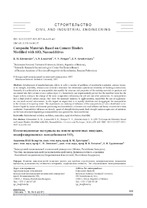Composite Materials Based on Cement Binders Modified with SiO₂ Nanoadditives

Date
2017Publisher
Another Title
Композиционные материалы на основе цементных вяжущих, модифицированных нанодобавками SiO₂
Bibliographic entry
Composite Materials Based on Cement Binders Modified with SiO₂ Nanoadditives = Композиционные материалы на основе цементных вяжущих, модифицированных нанодобавками SiO₂ / B. M. Khroustalev [et al.] // Наука и техника. – 2017. – № 5. - С. 459-465.
Abstract
Development of nanotechnologies allows to solve a number of problems of construction materials science: increase in strength, durability, abrasion and corrosion resistance that determines operational reliability of building constructions. Generally it is achieved due to nanoparticles that modify the structure and properties of the existing materials or products and are entered into their volume or on a surface layer. It’s theoretically and experimentally proved that the modified water has the bigger activity owing to the change of the ionic composition influencing the рН size and other parameters. As nanoparticles have a high level of surface energy, they show the increased tendency to agglomeration, meanwhile the size of agglomerates can reach several micrometers. In this regard an urgent task is to equally distribute and disaggregate the nanoparticles in the volume of tempering water. The experiments on studying of influence of the nanoparticles of silica distributed in volume of liquid by means of ultrasonic processing on characteristics of cement and sand solution and heavy concrete have been conducted. Nanoadditive influence on density, speed of strength development, final strength under compression of materials on the basis of cement depending on nanoadditive mass percent has been established.
Abstract in another language
Развитие нанотехнологий позволяет решить ряд проблем строительного материаловедения: повышение прочности, долговечности, стойкости к истиранию, коррозионная стойкость. Это обусловливает эксплуатационную надежность строительных конструкций, что в основном достигается за счет модификации структуры и свойств существующих материалов или изделий наночастицами, вводимыми в их объем или наносимыми на поверхностный слой. Теоретически и экспериментально установлено, что модифицированная вода обладает большей активностью вследствие изменения ионного состава, влияющего на величину рН и другие параметры. Поскольку наночастицы обладают большой поверхностной энергией, они проявляют повышенную склонность к агломерации, при этом размер агломератов может составлять несколько микрометров. В связи с этим актуальной задачей является равномерное распределение и дезагрегация наночастиц в объеме воды затворения. Проведены эксперименты по изучению влияния наночастиц кремнезема, распределенных в объеме жидкости с помощью ультразвуковой обработки, на характеристики цементно-песчаного раствора и тяжелого бетона. Установлено влияние нанодобавки на плотность, скорость набора прочности, конечную прочность на сжатие материалов на основе цемента в зависимости от массового процента нанодобавки.
View/
Collections
- №6[11]
